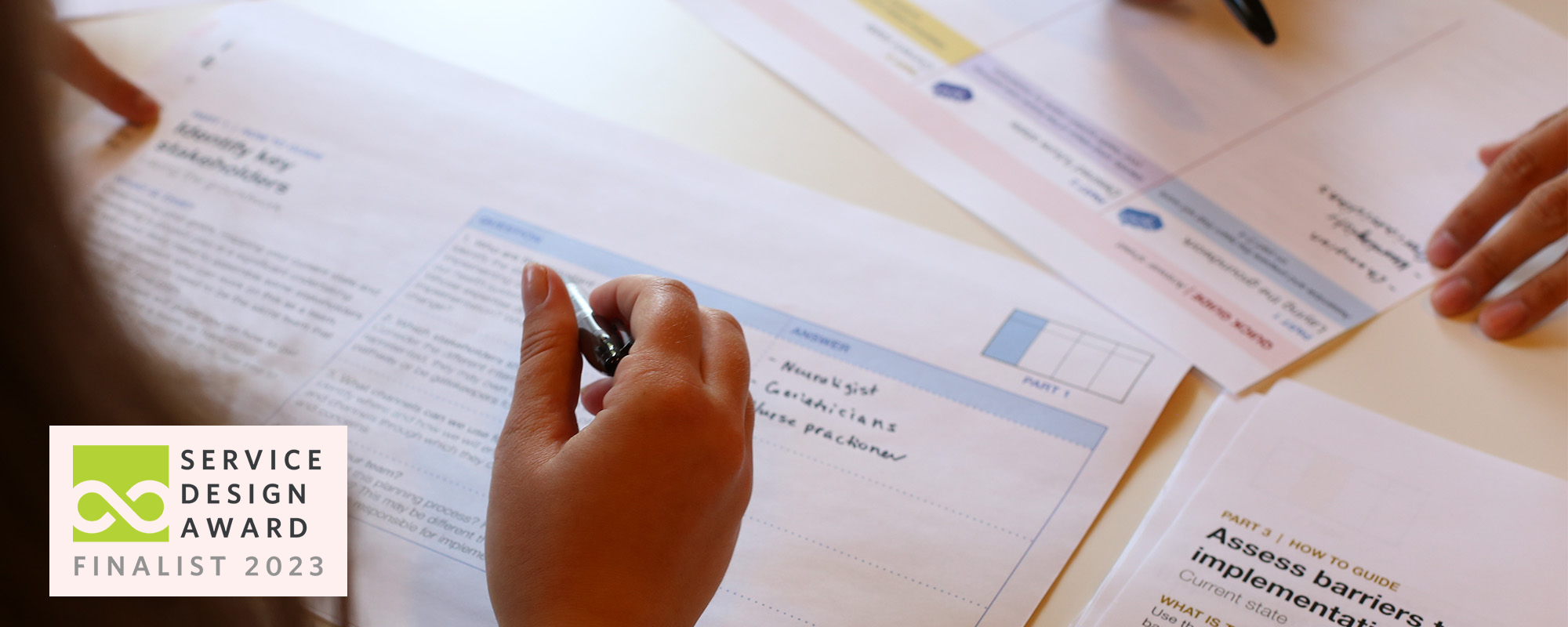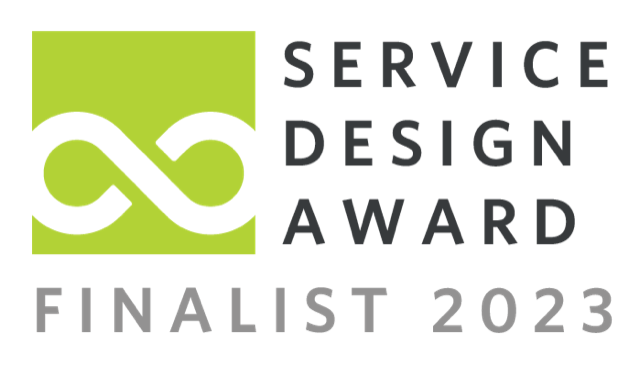
Work Bridgeable
Transforming the US health system: Designing a new era of Alzheimer’s Disease care
Problem
Our client sought to support the development of healthcare system readiness for an anticipated influx of Alzheimer’s Disease (AD) patients and the introduction of new treatments.
Solution
We developed an implementation toolkit, a comprehensive resource that equips healthcare professionals with practical strategies to navigate the complex landscape of Alzheimer's Disease care.
Impact
The toolkit was met with enthusiasm by account managers, and has been rapidly adopted. It has improved collaboration with healthcare organizations and contributed to more widespread Alzheimer's readiness.
Author
- Bridgeable
Client
- A major American pharmaceutical company
|
|
This project was nominated as a Service Design Award Finalist in 2023 by the Service Design Network. |
The global prevalence of Alzheimer’s Disease is set to increase from 50 million to about 139 million by 2050. Preparing health systems around the world to respond to the growing Alzheimer’s patient population and advancements in early detection, diagnosis, and treatment is one of the most critical public health challenges of our time.
The Alzheimer’s Disease ecosystem is a fast-evolving and dynamic space, particularly with the emerging likelihood of new treatment options and new diagnostics on the horizon. This, coupled with the projected influx of new Alzheimer’s patients, creates a heightened sense of urgency. However, many health systems are not ready for the influx of patients or the Alzheimer’s Disease products in the pipeline. This convergence of environmental headwinds and lack of infrastructure to support these patients has the potential to slow innovation for those people who need therapeutics the most.
We partnered with a leading global pharmaceutical company that is also working in the Alzheimer’s Disease space. Together, we sought to better support their health system partners as they prepare to increase their readiness to deliver Alzheimer’s Disease care.
The challenge was twofold:
- To increase the buy-in and empowerment of Healthcare Organizations to create better care pathways for Alzheimer’s Disease in anticipation of emerging treatment options.
- Support the implementation of new care pathways so that those who might benefit from these treatments are able to be identified and receive access to care.
A 4-phase approach to equipping healthcare professionals
We used a divergent and convergent design thinking cycle, drawing on a variety of qualitative methodologies and tools from our service design toolkit. Our approach consisted of 4 phases:
- Discover
- Define
- Design
- Deliver
Phase 1, Discover
It was critical to first gain a holistic and comprehensive understanding of the current state of Alzheimer’s Disease care in the US, the existing stakeholders and how they’re interconnected, and the barriers and enablers that exist in the ecosystem.
We gathered these insights through:
- Desk research and literature reviews
- Interviews with stakeholders representing our partner’s brand, healthcare organizations, and field and physician perspectives
- Interviews with key opinion leaders, representing a mix of healthcare organization types and medical specialties
We developed an initial ecosystem map of all stakeholders, information streams, funding sources, and services. We also captured differences between different levels of readiness among healthcare organizations through the use of archetypes (similar to personas, but representing the healthcare organizations).
We learned that “the biggest challenge is to solidify the care coordination”. When speaking about increasing healthcare organization readiness, we heard that inter-departmental coordination is one of the biggest issues in providing a seamless care experience. This was also identified as a key challenge for healthcare organizations in preparation of receiving a large influx of new patients when disease-modifying therapies become more readily available.
With this, we were able to develop an initial draft of the care pathway to take into the next phase of research.
I’m excited to find ways to implement this. Even with the highest performing health systems, this will help fill critical gaps.
- Senior Director, Strategy and Marketing
Phase 2, Define
In phase 2, we brought our learnings into engagement labs and advisory board workshops with Alzheimer’s healthcare practitioner advisors, health system executive advisors, and client stakeholders.
The advisory boards with clinicians and healthcare executives helped us to define what a strategic partnership between industry partners might look like, as well as gather insights into their on-the-ground experiences delivering Alzheimer’s care, including frustrations and needs, followed by collaboratively crafting strategies to overcome them. These engagements allowed us to synthesize the information we collected through our research and ensure alignment with the client on our findings.
Our research and synthesis not only provided us with first-hand accounts of the barriers and enablers to the implementation of care pathways across the health ecosystem, but the workshops also allowed us to rapidly test, iterate, and validate our thinking and potential outputs collaboratively with health system stakeholders, our pharmaceutical partner, and account managers–leading to our third phase.
Phases 3 and 4, Design and Deliver
Our research and alignment led us to a tool that our pharmaceutical partner can employ to address the initial challenge. The solution was the Implementation Toolkit, which provides guidance and tactics for healthcare organizations as they work to make the care pathway a reality. It consists of several components, including:
- A Future State Care Pathway for Alzheimer’s Disease
- A four-step implementation framework
- Common barriers and enablers to care pathway implementation
- Supporting tools to guide implementation efforts in healthcare organizations
We initially designed low-fidelity prototypes that were iteratively developed into high-fidelity prototypes with our client stakeholders, and then a final version through testing and validation workshops.
The implementation toolkit can be used with health system leaders who are looking to prepare their organizations for the future of Alzheimer’s Disease care by evolving and scaling care pathways. The toolkit brings the future care pathway to life and guides healthcare organizations through the development of an implementation plan in four parts and consists of building blocks that can be put together and taken apart to reflect the unique needs of each healthcare system.
I’ve never seen this much excitement from our field team about a resource before.
- Associate Vice President, Strategy and Marketing
Thinking differently with actionable strategies
The work helped our client think differently about their positioning in the market: shifting from primarily being an innovator/driver of research breakthroughs to also being a partner. To help them build capacities, we’ve equipped the account managers with actionable strategies and tools to use. Early successes point to the insights and strategies the tools are based on being highly credible.
Leveraging expert input and engagement with health system leaders, we devised an ideal future state care pathway for Alzheimer’s Disease, which helps articulate what good looks like for a disease state where protocols or pathways are underdeveloped and underdefined. Together, we identified feasible and impactful strategies our client could act on to act as an enabler, connector, and capacity builder in the health system.
This was achieved by developing an implementation toolkit that was to be shared with account managers to action and share with their healthcare organization partners. It consists of the future state care pathway, implementation steps, requirements and enablers, challenges, and strategies to overcome them.
Equipping the Implementation Toolkit
The Implementation Toolkit that we designed in collaboration with our partner is just now breaking into the market. Notably, there has been resounding excitement from our client’s account managers regarding the tools that are provided within the Implementation Toolkit and the impact they will have in the field with health systems. Here is what we’ve heard:
- “I’ve never seen this much excitement from our field team about a resource before”
- “I’m excited to find ways to implement this. Even with the highest performing health systems, this will help fill critical gaps”
- “I love how interactive and customizable the tool is”
Similarly, we have heard from our client’s project champions that more than 50% of their account managers have already put the implementation toolkit into practice with their health system customers, demonstrating a high level of buy-in and perceived utility of the tool, as well as early success stories emerging from the use of the toolkit with specific health systems. The Implementation Toolkit has been circulated to a number of other therapeutic areas within our client organization as they seek to make similar progress.
How can this translate to other therapeutic areas?
With a disease state like AD, where care pathways are so underdeveloped and under-defined, it’s critical to start by defining what the ideal future state would look like. Working backward from there, you can identify the implementation barriers and enablers within each unique health system and begin tackling them. Care pathways are fundamental to establishing system readiness.
For change to happen in the Alzheimer’s space and other notoriously complex disease states, vast stakeholder networks need to come together and reconcile hugely varying interests and incentive models. Design research and change management methods help find the right path forward. Collaborative design methods are critical in these efforts. Early engagements in this project started by exploring the question ‘What does a good interaction with pharma look like?’ with key stakeholders. This helped lay a foundation for buy-in, for sharing perspectives that don’t always align, and created lots of room for impactful and lasting collaborative design.
The learnings through this AD journey teach that driving health system readiness requires an all-hands-on-deck approach, with partnership between industries, health systems, and advocacy groups being a critical success factor in getting this right. There’s no time to waste in building care pathways that ensure patients who could benefit from new therapies can access them as soon as possible.
